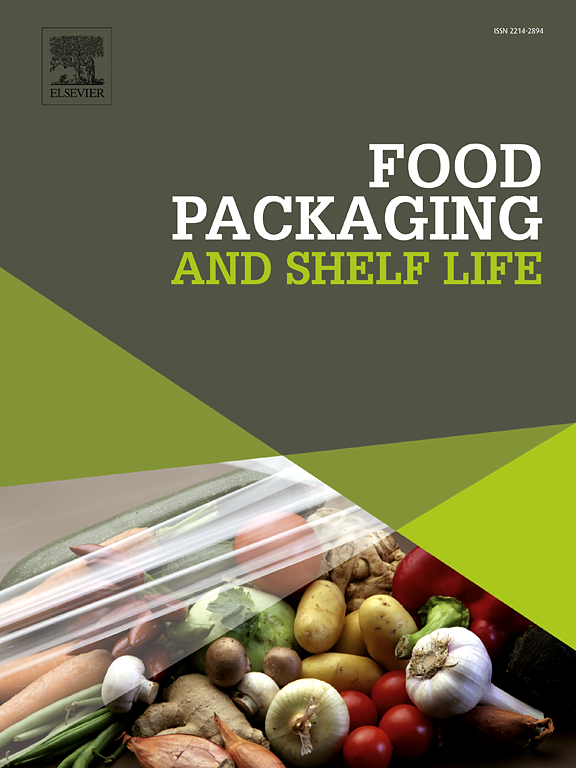Effect of active rice straw extracts on the properties and migration of PHBV films
IF 8.5
1区 农林科学
Q1 FOOD SCIENCE & TECHNOLOGY
引用次数: 0
Abstract
Rice straw extracts (RSE) were obtained by subcritical water extractions at 160 °C (RSE160) and 180 °C (RSE180). These extracts were analysed as to the main components, phenol content and formation of 5-Hydroxymethylfurfural(5-(hydroxymethyl)furan-2-carbaldehyde (HMF). These were incorporated (6 % wt.) into PHBV films by melt blending and compression moulding. Films were characterised as to their physical properties, structural and thermal behaviour, and overall and specific migration of the phenols and HMF in different food simulants. Thermal processing of the films led to a partial degradation of the extracted sugars, producing micro-holes in the matrix and HMF formation. The RSE slightly reduced the polymer crystallinity, the film stretchability, fracture resistance, and barrier capacity to water vapour and limonene, but improved the oxygen barrier of the films and enhanced their UV light barrier due to the phenol content and antioxidant capacity. The PHBV migration did not reach the overall migration limit (10 mg/dm2) in any simulant while the specific migration of phenols and HMF depended on the food simulant and its concentrations in the films. The near total release of the phenols present in the films was achieved in less polar simulants, equivalent to 30–40 mg GAE/kg of packaged food, for RSE180 films. HMF was mainly released in acidic simulants and those containing ethanol, reaching a maximum value of 0.36 mg/kg, for RSE180 films in which more HMF was formed. This value was much lower than those HMF levels found in many commonly-consumed foods. Therefore, the materials can be considered safe for food packaging.
活性稻草提取物对PHBV膜性能及迁移的影响
在160°C (RSE160)和180°C (RSE180)下进行亚临界水提取,得到稻草提取物(RSE)。对这些提取物的主要成分、酚含量和5-羟甲基糠醛(5-(羟甲基)呋喃-2-甲醛(HMF)的生成进行了分析。通过熔融混合和压缩成型将这些材料(6 % wt.)加入PHBV薄膜中。表征薄膜的物理性质,结构和热行为,以及酚类和HMF在不同食品模拟物中的整体和特定迁移。薄膜的热加工导致提取的糖的部分降解,在基质中产生微孔和HMF的形成。RSE略微降低了聚合物的结晶度、薄膜的拉伸性、抗断裂性以及对水蒸气和柠檬烯的阻隔能力,但由于苯酚含量和抗氧化能力,提高了薄膜的氧阻隔性和紫外线阻隔性。PHBV在任何模拟物中的迁移均未达到总迁移极限(10 mg/dm2),而酚类和HMF的特定迁移取决于食物模拟物及其在膜中的浓度。在极性较低的模拟物中,RSE180薄膜中存在的酚类几乎完全释放,相当于30-40 mg GAE/kg包装食品。HMF主要在酸性模拟物和含乙醇模拟物中释放,在形成较多HMF的RSE180膜中,释放量最大,为0.36 mg/kg。这一数值远低于许多常见食物中发现的HMF水平。因此,可以认为这些材料用于食品包装是安全的。
本文章由计算机程序翻译,如有差异,请以英文原文为准。
求助全文
约1分钟内获得全文
求助全文
来源期刊

Food Packaging and Shelf Life
Agricultural and Biological Sciences-Food Science
CiteScore
14.00
自引率
8.80%
发文量
214
审稿时长
70 days
期刊介绍:
Food packaging is crucial for preserving food integrity throughout the distribution chain. It safeguards against contamination by physical, chemical, and biological agents, ensuring the safety and quality of processed foods. The evolution of novel food packaging, including modified atmosphere and active packaging, has extended shelf life, enhancing convenience for consumers. Shelf life, the duration a perishable item remains suitable for sale, use, or consumption, is intricately linked with food packaging, emphasizing its role in maintaining product quality and safety.
 求助内容:
求助内容: 应助结果提醒方式:
应助结果提醒方式:


